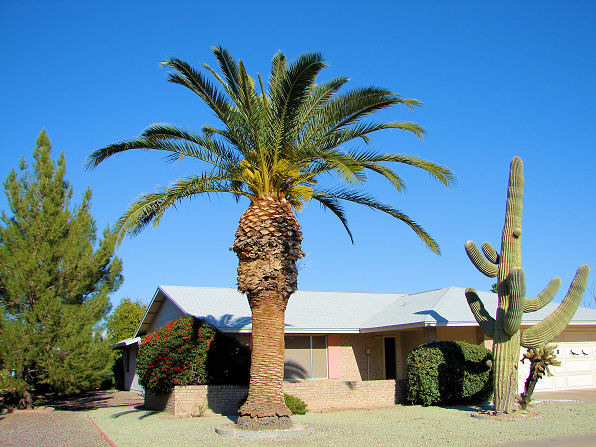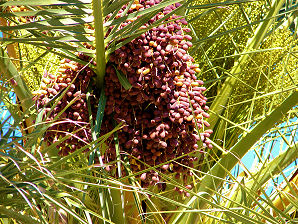Non - Xeriscape.
Common Landscape Plants. Shrubs, Flowers, & Trees.
For The Arizona Desert Environment
Pictures, Photos, Images,
Descriptions, & Reviews.
Canary Island Date Palm, Phoenix canariensis.
We Are Proud Of Our SafeSurf Rating!
Click On Any Of The Following Links By Amazon.Com
To View Tools For Desert or Arizona Gardening. No Obligation!
 |
| Canary Island Date Palm, Phoenix canariensis. Arrowhead Ranch, Glendale, Arizona. January 21, 2006. Pineapple Palm And Canary Island Palm Are The Same Tree! |
|---|
 |
| Pineapple Date Palm, Phoenix canariensis. Sun City, Arizona. January 21, 2006. This Bottom Tree Is About 45 Years Older! |
|---|
 |  |
| Canary Island Date Palm. Phoenix canariensis. | Canary Island Date Palm. Phoenix canariensis. |
|---|
Canary Island Date Palm.
We wish to thank Wikipedia, the free encyclopedia for some of the information on this page. We share images and information with Wikipedia. The Canary Island date palm is very widely planted as an ornamental plant in warm temperate regions of the world, particularly in areas with Mediterranean climates. Massive and imposing, the Canary Island Date Palm or Pineapple Date Palm is the center of attention wherever it is planted. Growing up to 60' tall, the thick, hulking trunk is covered with interesting diamond designs that mark the point of attachment of the leaves. The massive trunk supports a huge crown of over 50 huge arching pinnate leaves that may reach 18 feet long. These leaves are deep green shading to a yellow stem where the leaflets are replaced by vicious spines. The orange colored dates are formed on drooping, highly branched infloresences and are very decorative. They are edible but not very tasty. Phoenix canariensis is native to the Canary Islands which are located in the Atlantic Ocean off the coast of Northeast Africa. These stately palms are popular landscape items in near frost-free climates around the world. They are grown all along the Gulf of Mexico coastline. They are planted in warm areas of the western U.S. including Arizona, California and Nevada. This palm is very slow growing when young. Once the trunk reaches it's full diameter the growth rate increases. You should fertilize it in the spring and summer. We do not recommend this palm tree for residences unless you have a really BIG yard or a mansion (which they decorate very nicely!) This palm is best used along boulevards, on campuses and in parks and grouped in trios to form focal points in cityscapes.
Quick Notes:
Height: Up to 60 feet tall. Frond spread of 20 - 40 feet.
Flowers: Dioecious; on dense, hanging many-branched 1 foot long clusters, creamy yellow - white, opening from a husk-like structure, appearing periodically throughout the year.
Flowering Time: Southern Arizona, March - April. Phoenix Area, April - May.
Fruit & Seeds: A fleshy drupe, elliptical, 1/2 to 1 inch long, orange - brown to dark purple, date - like, occuring in up to 18 inch hanging clusters, they ripen in the summer and are considered edible. We think they taste terrible.
Trunks: Up to 4 feet diameter, brown to gray.
Leaves: Alternate, pinnately compound, up to 20 feet long, arching gracefully; the individual leaflets are lance - shaped, 12 to 18 inches long, lower half of the petiole is covered with 2 - 3 inch sharp spines, shiny dark green above, feathery.
Found: Native to Brazil, Paraguay and northern Argentina in South America. Found throughout Arizona at lower elevations. The USDA claims it is native to the USA (CA, FL).
Hardiness:
Soil pH requirements:
Sun Exposure:
Elevation: In Arizona usually at 0 - 2,600 feet. In California it grows between between 0 and 3,281 feet.
Habitat: Lower elevations where water is available. It grows well in sand, sandy loam, clay and other heavy soils. It needs good drainage and aeration. It is remarkably tolerant of alkali. In its native habitat it is found at the base of "barrancos" where, even during the dry season, a small amount of water is always present in the soil.
Miscellaneous: Flowering Photos Taken At Glendale, Arizona. January 21, 2006. Maintenance: Low. Pool friendly.
|
We Are Proud Of Our SafeSurf Rating!
Click On Any Of The Following Links By Amazon.Com
To View Tools For Desert or Arizona Gardening. No Obligation!
| © 1966 - Present, Audrey, Eve, & George DeLange |




